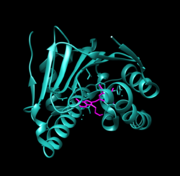Sandbox chaperones
From Proteopedia
| Line 1: | Line 1: | ||
| + | |||
| + | == Chaperones == | ||
| + | |||
This page is setup for Paige to build her senior project for OU CHEM 4923 | This page is setup for Paige to build her senior project for OU CHEM 4923 | ||
| Line 4: | Line 7: | ||
The primary function of chaperones is protein folding. They are proteins that assist/chaperone other proteins as they fold or unfold and assemble or disassemble in order to prevent misfolding and unwanted protein aggregation. | The primary function of chaperones is protein folding. They are proteins that assist/chaperone other proteins as they fold or unfold and assemble or disassemble in order to prevent misfolding and unwanted protein aggregation. | ||
| - | Some chaperones function closely with ribosomes in order to help fold newly made proteins, sometimes co-translationally. However, most proteins will fold spontaneously without the help of a chaperone. Chaperones become necessary for most proteins only when the intracellular environment becomes too crowded, thus increasing the chances of protein aggregation unless aided by a chaperone. <ref | + | Some chaperones function closely with ribosomes in order to help fold newly made proteins, sometimes co-translationally. However, most proteins will fold spontaneously without the help of a chaperone. Chaperones become necessary for most proteins only when the intracellular environment becomes too crowded, thus increasing the chances of protein aggregation unless aided by a chaperone. <ref>Ellis, R.J. and van der Vies, S.M. (1991). "Molecular chaperones". Annual Review of Biochemistry 60: 321–47</ref> |
| - | Many chaperones are heat shock proteins that are expressed in response to high temperatures or other cellular stresses which impact protein folding. In these environments chaperones function to prevent or correct damage caused by misfolding and to prevent unwanted protein aggregation, which is more likely to happen when proteins are denatured by stress. Some heat shock protein chaperones are present at low to moderate levels in virtually all organisms at all times in order to help in essential protein maintenance. | + | Many chaperones are heat shock proteins that are expressed in response to high temperatures or other cellular stresses which impact protein folding. In these environments chaperones function to prevent or correct damage caused by misfolding and to prevent unwanted protein aggregation, which is more likely to happen when proteins are denatured by stress. Some heat shock protein chaperones are present at low to moderate levels in virtually all organisms at all times in order to help in essential protein maintenance. |
<Structure load='3hhu' size='350' frame='true' align='right' caption='Human HSP90 3HHU' /> | <Structure load='3hhu' size='350' frame='true' align='right' caption='Human HSP90 3HHU' /> | ||
| Line 21: | Line 24: | ||
== References == | == References == | ||
| - | < | + | <references/> |
Revision as of 13:18, 17 December 2015
Contents |
Chaperones
This page is setup for Paige to build her senior project for OU CHEM 4923
Function
The primary function of chaperones is protein folding. They are proteins that assist/chaperone other proteins as they fold or unfold and assemble or disassemble in order to prevent misfolding and unwanted protein aggregation. Some chaperones function closely with ribosomes in order to help fold newly made proteins, sometimes co-translationally. However, most proteins will fold spontaneously without the help of a chaperone. Chaperones become necessary for most proteins only when the intracellular environment becomes too crowded, thus increasing the chances of protein aggregation unless aided by a chaperone. [1]
Many chaperones are heat shock proteins that are expressed in response to high temperatures or other cellular stresses which impact protein folding. In these environments chaperones function to prevent or correct damage caused by misfolding and to prevent unwanted protein aggregation, which is more likely to happen when proteins are denatured by stress. Some heat shock protein chaperones are present at low to moderate levels in virtually all organisms at all times in order to help in essential protein maintenance.
|
Energetics
Structural highlights
Disease
References
- ↑ Ellis, R.J. and van der Vies, S.M. (1991). "Molecular chaperones". Annual Review of Biochemistry 60: 321–47

